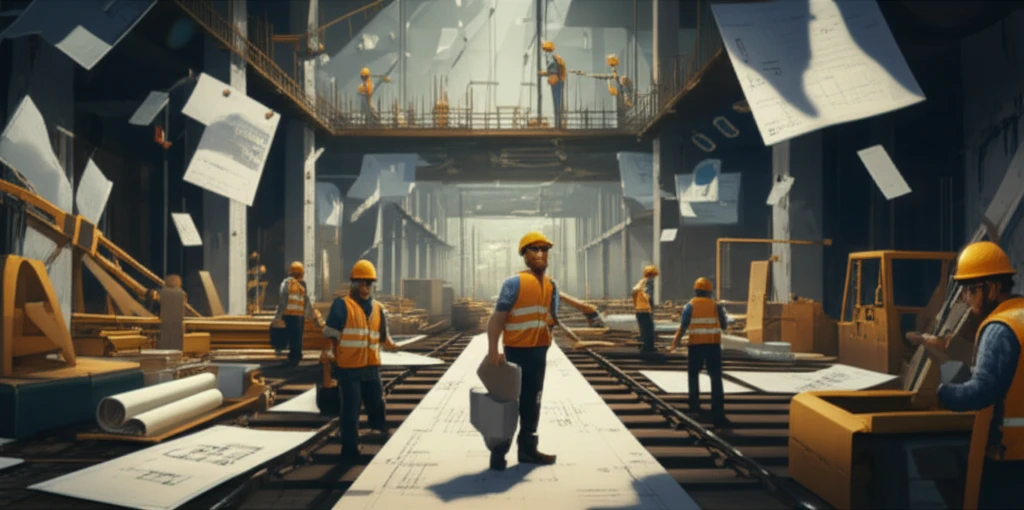
Metro Project Mayhem: Why Design Reviews Go Off the Rails (and How to Fix It)
"Uncover the hidden pitfalls in metro project design processes and learn how better management can prevent costly delays and ensure client satisfaction."
Construction projects, especially large-scale public endeavors like metro systems, are incredibly complex. They demand seamless collaboration between specialists to achieve sustainable and successful outcomes. However, in developing economies, these projects often face heightened risks, making careful planning and execution crucial for client satisfaction.
A smooth design process is essential. It requires efficient workflows and clear communication to translate client needs into detailed, functional designs. When this process breaks down – due to unclear requirements, team miscommunication, or management issues – the consequences can be severe: delays, increased costs, and ultimately, dissatisfied clients.
This article examines a research paper that investigates the design review process of a metro project in Doha, Qatar. By uncovering the managerial and procedural weaknesses, we'll explore how these challenges impact project efficacy and what steps can be taken to ensure smoother, more successful project outcomes. The core question is: How can management practices in metro projects be improved to better serve clients and deliver successful results?
Decoding the Design Disaster: Key Issues Uncovered

The research identified several recurring themes that contribute to design review inefficiencies. These issues highlight the critical areas where managerial attention and process improvements are most needed:
- Management Interference: Internal conflicts and a lack of coordination among design managers disrupt the design process. When managers prioritize their own agendas over the project's overall goals, it leads to confusion and inefficiency. Moreover, managers who operate with a perceived sense of superiority, disregarding the expertise of their teams, further compound the problem.
- Technical Issues: A disconnect between client requirements and actual design outcomes is a major concern. Missing design documentation, a reliance on outdated data, and a failure to incorporate industry best practices undermine the technical integrity of the project. The absence of clear specifications and the use of 'preferential status' based on consensus, rather than sound engineering principles, exacerbate these issues.
- Contractor Design Manager Issues: Lack of transparency in the design contractor's approval process, combined with a failure to adhere to established protocols, results in unverifiable and unsupported design outputs. Without proper documentation and adherence to project management standards, the design process becomes chaotic and unreliable.
- Documentation Issues: Inadequate documentation practices plague the project. A lack of documented procedures, unsigned documents, and a general failure to record meeting outcomes create confusion and hinder accountability. This absence of a clear paper trail makes it difficult to track progress and resolve disputes.
- Communication Issues: Poor communication channels, characterized by uncoordinated emails and a lack of formal contact procedures, further impede progress. When team members are not kept in the loop and external parties are contacted without proper authorization, it creates a fragmented and inefficient design environment. The absence of key specialists, such as quality management and risk managers, further weakens the design team's capabilities.
Turning the Tide: Strategies for a Successful Metro Project Design
The research highlights the critical need for a more integrated and collaborative approach to metro project design. Effective management of design practices hinges on establishing cohesive procedures, clear plans, and robust managerial oversight. This ensures that client requirements are consistently met while minimizing costs and delays.
To overcome the identified challenges, metro projects should prioritize the following:
<ul><li>Improved Managerial Training: Invest in training programs to equip design project managers with the skills and knowledge needed to effectively lead and coordinate complex projects.</li><li>Enhanced Communication Protocols: Implement clear communication channels and formal contact procedures to ensure that all team members are informed and aligned.</li><li>Robust Documentation Practices: Enforce strict documentation standards to maintain a clear record of design decisions, meeting outcomes, and project progress.</li><li>Integrated Design Approach: Foster collaboration between design and construction teams, integrating construction expertise into the design process from the outset.</li><li>Transparency and Accountability: Establish clear lines of accountability and promote transparency in all design and approval processes.</li></ul> By addressing these critical areas, metro projects can improve their design review processes, minimize costly delays, and ultimately deliver successful outcomes that meet and exceed client expectations.
